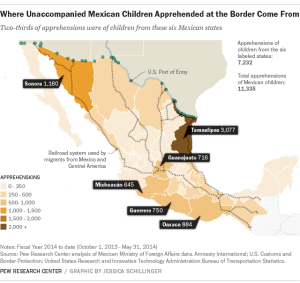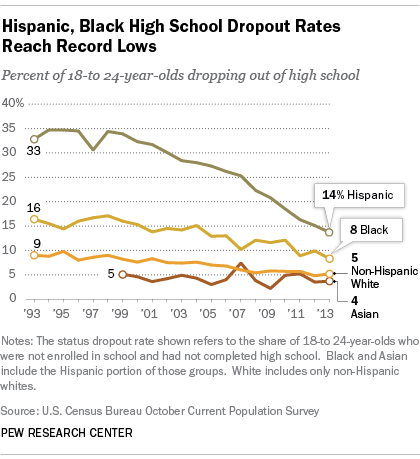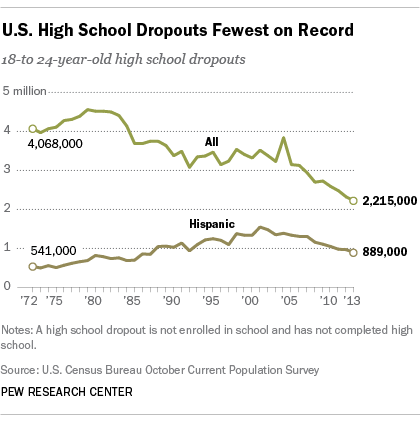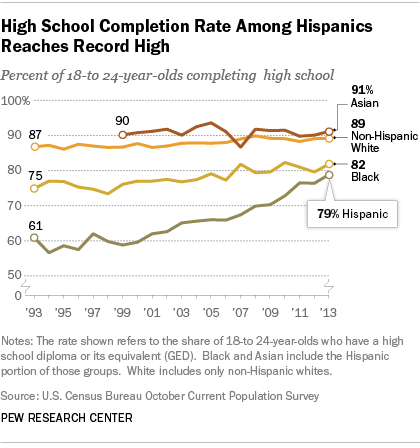
More U.S. high school students are staying in school, according to newly released data from the Census Bureau, as the national dropout rate reached a record low last year. Just 7% of the nation’s 18-to-24 year olds had dropped out of high school, continuing a steady decline in the nation’s dropout rate since 2000, when 12% of youth were dropouts.

The decline in the national dropout rate has been driven, in part, by substantially fewer Hispanic and black youth dropping out of school (the non-Hispanic white dropout rate has not fallen as sharply). Although Hispanics still have the highest dropout rate among all major racial and ethnic groups, it reached a record-low of 14% in 2013, compared with 32% of Hispanic 18- to 24-year-olds who were dropouts in 2000.
The new data show significant progress over the past decade at other measures of educational attainment among Hispanic youth: Not only are fewer dropping out of high school, but more are finishing high school and attending college. The only exception is that Hispanics continue to substantially trail white youth in obtaining bachelor’s degrees.

The decline in the size of the Hispanic dropout population has been particularly noteworthy because it’s happened at the same time that the Hispanic youth population is growing. The number of Hispanic 18- to 24-year-old dropouts peaked at 1.5 million in 2001 and fell to 889,000 by 2013, even though the size of the Hispanic youth population has grown by more than 50% since 2000. The last time the Census Bureau counted fewer than 900,000 Hispanic dropouts was in 1987.
Aside from the Great Recession, the trend in more Hispanic youth staying in school is occurring against the backdrop of diminishing job opportunities for less-educated workers, including less-educated Hispanic workers. Hispanic students and their families may be responding to the rising returns to a college education by staying in school.

Indeed, census data show that Hispanics have reached a record high school completion rate.
Among Hispanic 18- to 24-year-olds, 79% had completed high school compared with 60% who did so in 2000. High school completion rates have also been rising for other racial and ethnic groups, but their rates were not at record highs in 2013.
For Hispanics, education has long been a top issue; in Pew Research surveys, Hispanics often rank education as one of the most important issues, along with health care and immigration. Hispanics also made up 25% of the nation’s public school students in 2013, with that share projected to rise to 30% by 2022.
Hispanics have also made progress in college enrollment at two- and four-year schools. Among college students ages 18 to 24, Hispanics accounted for 18% of college enrollment in 2013, up from 12% as recently as 2009, according to the new census data.
But young Hispanics still lag behind in earning four-year college degrees. Hispanic students account for just 9% of young adults (ages 25 to 29) with a bachelor’s degree. By comparison, whites account for about 58% of students ages 18 to 24 enrolled in college and 69% of young adults with a bachelor’s degree.
The dropout rate for black youth also was at a record low in 2013 (8%) and has fallen by nearly half since 2000 (15%). Blacks comprised 16% of the nation’s public school students in 2013, with that share projected to fall to 15% by 2022.
Among non-Hispanic white youth, the dropout rate has also declined since 2000 to 5% in 2013.
Asian youth continue to be the major racial group with the lowest high school dropout rate (4% in 2013), but it was not at a record low last year.

